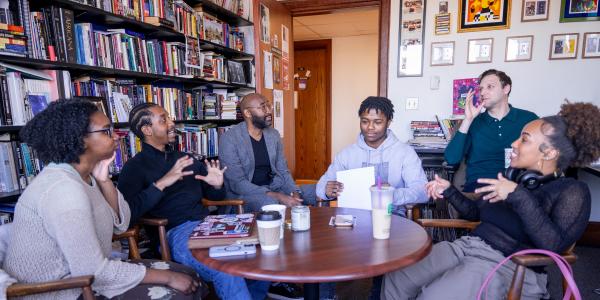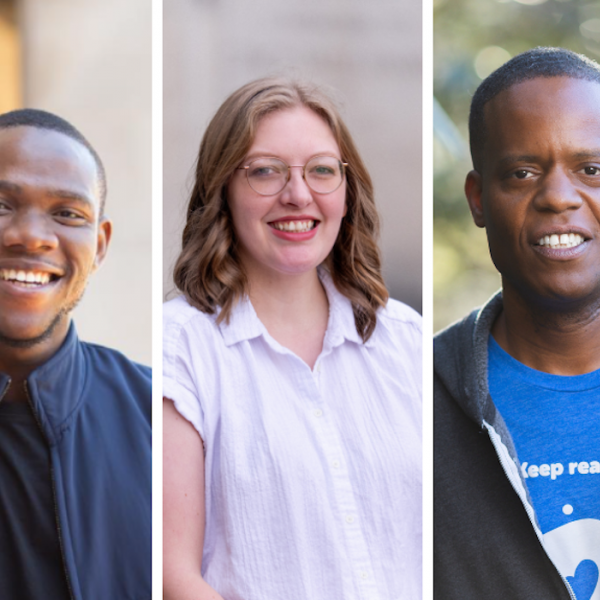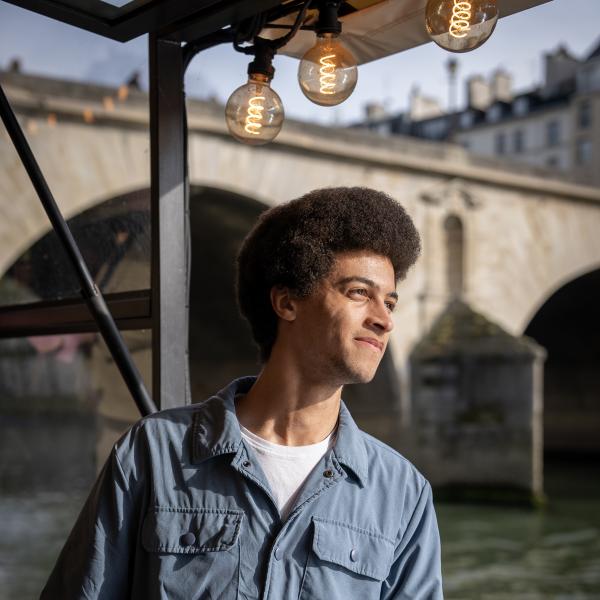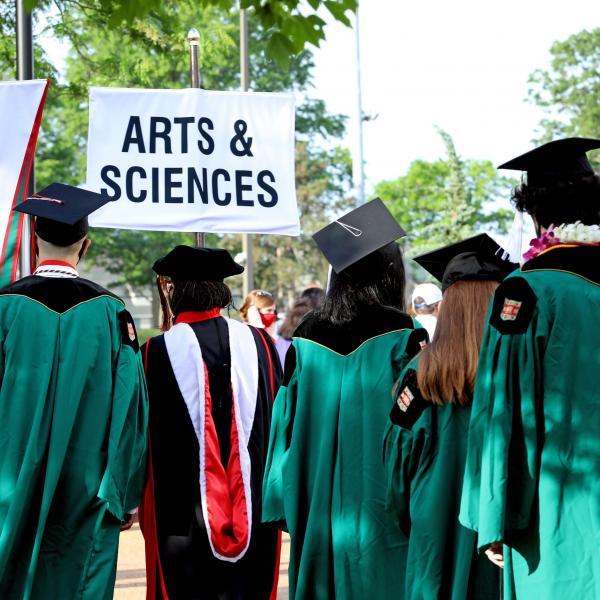Faculty members Jonathan Fenderson and Zachary Manditch-Prottas are uniting students from diverse disciplines in a rigorous study of hip-hop and rap, the predominant music of their generation.
In the 50 years since hip-hop debuted on the music scene, it has moved from outsider art to a dominant force in popular culture, influencing everything from fashion to language to visual art. College students today don’t know a world without it.
In their course “Beats, Rhymes & Life: A Cultural History of Hip-Hop,” Jonathan Fenderson, associate professor of African and African American Studies, and Zachary Manditch-Prottas, lecturer in African and African American Studies and American culture studies, guide students through the world that shaped the music. They examine the rhythms, lyrics, and historical context behind the music and attempt to understand what the rise of this genre means for society today.
“Before Zach came to WashU, I hadn’t had any intellectual partners around rap,” Fenderson said. “I realized this can be a rich, rigorous conversation that forms the basis for cutting-edge work.”
As the two talked, they began to see how the subject might make for an appealing course for students across Arts & Sciences who are hungry to perform deep, interdisciplinary analysis. It also formed the basis for an Ampersand program, “50 Years of Hip-Hop,” which allows first-year students to study the topic for two semesters and travel to New York in the spring.
Like the music they examine, Fenderson and Manditch-Prottas are a study in contrasts. Fenderson is from the West Coast; Manditch-Prottas comes from the East Coast. Both are African and African American Studies professors, but Fenderson works more like a traditional historian with an emphasis on archival work while Manditch-Prottas specializes in literary, gender, and sexuality theory.
The 35 students in their course also come from diverse backgrounds. Some are dedicated fans of the music while others signed up with little knowledge of the genre or its context. “The range of entry points is what makes the conversation so dynamic,” Fenderson said. “People are coming with their own interests.”
The seminar-style course encourages students to apply a range of artistic and scientific questions to a shared topic, fostering new insights into a genre that, for many, is part of daily life.
“This is complicated, boundary-breaking music,” Manditch-Prottas said, “and the students take it very seriously.”

The Scientist: Ron Fishman
Growing up in New Jersey, Ron Fishman would put on headphones and listen to rap his entire bus ride to middle school. It was his daily escape, comfort, and safe space, he said. Music has always been important in Fishman’s life thanks to his family — his grandmother was a music teacher and his father raised him on a steady diet of Beatles records — but as a first-generation American raised near New York City, rap was the music that resonated.

He was scrolling through the WashU course catalog last year when he saw “Beats, Rhymes & Life.” Now a senior biology major with a focus on neuroscience, he viewed the course as an opportunity to consider his favorite genre through a new academic lens.
Fishman is interested in how individual perception — a response based in the brain — changes a person’s reaction to a song. Scientists looking at brain activity on a functional MRI can see highly specialized regions of the brain illuminate when someone recognizes a face, for instance. But watch the brain activity of someone listening to rap, Fishman said, and it “lights up like a Christmas tree.” The auditory cortex engages to process tone. The prefrontal cortex is triggered to integrate and interpret emotions. If the music generates feelings such as nostalgia, the amygdala and hippocampus get involved. When we listen to something as complex and layered as hip-hop, he said, “the brain merges emotion, memory, and hearing all at the same time.”
But Fishman's interest in hip-hop isn't limited to neuroscience. Thanks to his joint interest in social sciences — he’s pursuing a minor in medical humanities — Fishman is also fascinated with the cultural side of the music. The active discussion and debate in the course have changed his understanding of many songs and artists.
“There are so many bright kids in the class from all over, all studying different things,” Fishman said. “I’ve had my eyes opened on certain issues, especially when it comes to hyper-masculinity and gender dynamics in the music. It has deepened my knowledge about how the genre interplays with politics at large.”
The Black Studies Scholars: Maya Phelps and Hady Sow
Maya Phelps and Hady Sow, seniors majoring in African and African American studies, welcomed the chance to apply a more intellectual lens to their favorite genre of music.
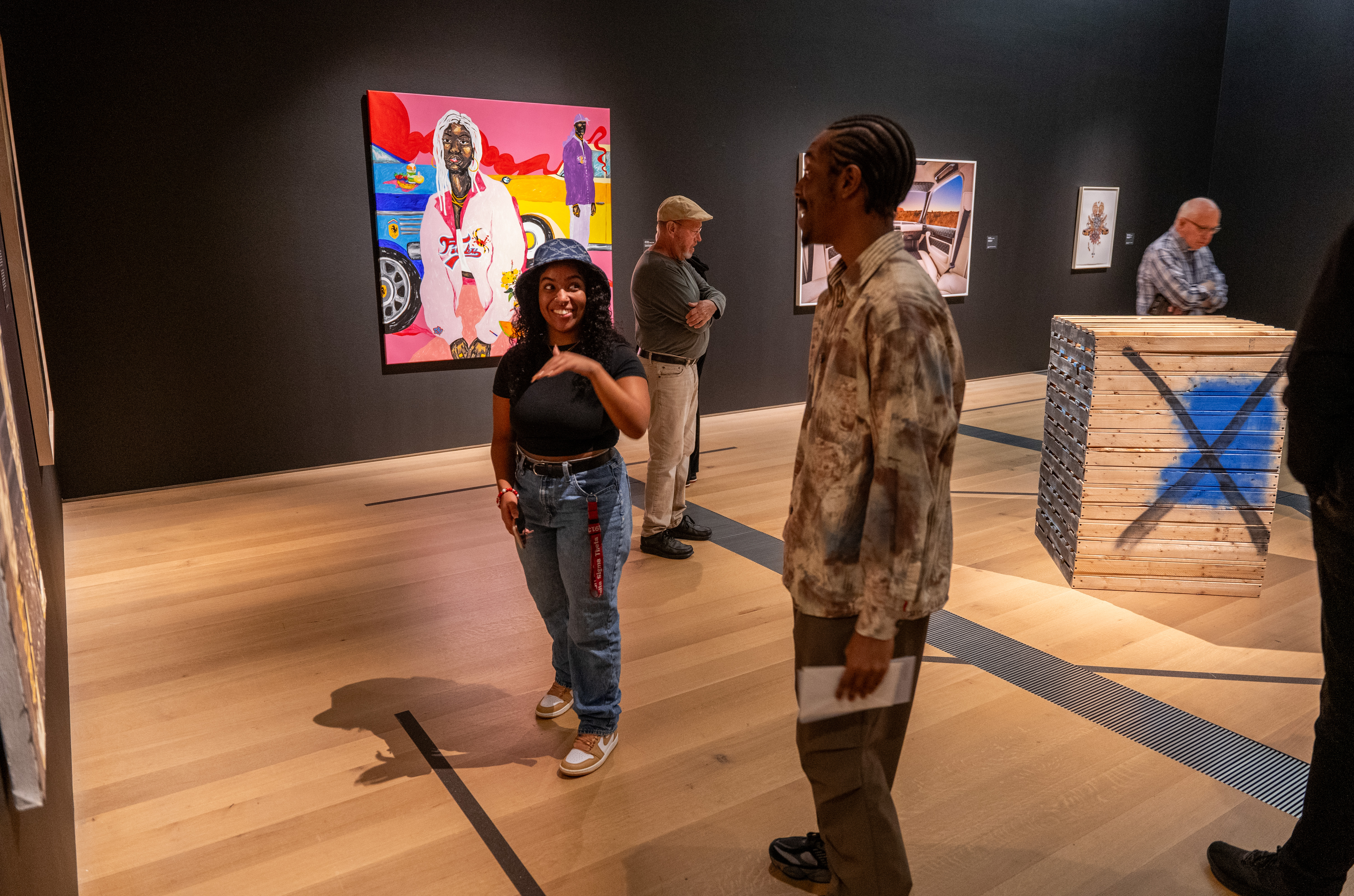
The themes of hip-hop can often seem heavy — poverty, trauma, and marginalization — but Phelps and Sow said the music is about so much more. "Black communities created this music to find joy amid structural violence by the state,” Phelps said. “Hip-hop emerged not only as a way to share their experiences but also as a cathartic, communal art form."
For Sow, a Bronx native, rap is tangible art. “Rap has been the soundscape of my life,” he said. The course has offered him a chance to consider the wider social and political context of the genre. He points to parallels between the music and political events taking place in the U.S. when the genre took root at the end of the 20th century, a challenging time for members of the African diaspora living in New York City.
“These songs express frustrations and lived experiences,” Sow said. “Some do that directly with lyricism, others use rhythm. But they all seem to chip away at some kind of social commentary.”
Phelps, a Mellon Mays fellow, studies the intersection of gender and race, which sparked her interest in understanding how Black women and queer people contributed to the genre. “Rap is positioned as male-centric, but so many women have paved the way,” she said, pointing to pioneers such as Roxanne Shanté, Salt-N-Pepa, MC Lyte, Foxy Brown, and Lil' Kim. The class has also given her the chance to turn an analytic eye toward some of the foundational songs of the genre. “A song can be looked at through a critical lens even if it’s canon,” she said.
For Phelps and Sow, rap and hip-hop are valuable vehicles to examine the lives of people who have often been overlooked in academia. “When it comes to Black people’s experiences in the U.S., this music is their reality, rooted in their actual lives,” Phelps said. A pop culture lens is a legitimate way to examine history, she added, allowing the people being studied to speak with their own words.
The Musician: David Oseni
For David Oseni, a sophomore majoring in philosophy-neuroscience-psychology, “Beats, Rhymes & Life” has been a way to stay connected to art while pursuing his dream of becoming a doctor.

“As a pre-med student, classes can get overwhelming,” he said. “This class is a way for me to balance my STEM-heavy course load and have an area to completely vent and express my creative passion.”
In his first year at WashU, Oseni took a course on the music of the African diaspora, tracing it from Africa to the Caribbean and, eventually, New York City. Fenderson’s and Manditch-Prottas’ class picks up where that course ends.
Oseni said the discussions in “Beats, Rhymes & Life” allowed him to participate in a wider cultural analysis of the genre. “Hip-hop was formed through community, created by people in the Bronx coming together to listen to songs, hear DJs scratch, and create new musical techniques during a time of disparity and violence,” he said. “The music was the foundation for people to come together, to use music as a path to joy.”
That’s how music works in Oseni’s life, too. He’s also a jazz guitarist who produces and mixes music in his free time. “Rhythms can express how you feel, and producing them is a really powerful way to do it.”
And while he initially signed up for the course as a counterbalance to his science studies, there’s been some surprising overlap with his major. Last year, the course “Technology & Selfhood” had Oseni considering music’s impact on relationships and emotions. Later, in an introductory psychology course, he learned how a parent’s genomes affect their child’s hearing, a lesson he thought about in the hip-hop course when they discussed the subjective experience of listening to a song.
“Beats, Rhymes & Life'' has brought into sharper focus the significant role hip-hop has played in both Oseni’s life and society. “Music is everywhere, and it is much more profound than a collection of 12 notes,” he said. “It is a means of motivation and expression."
